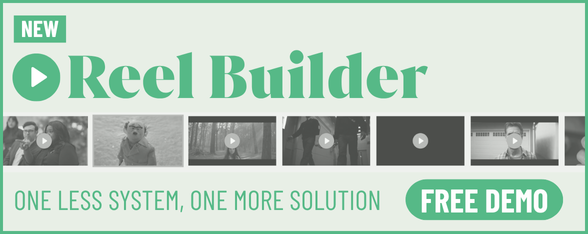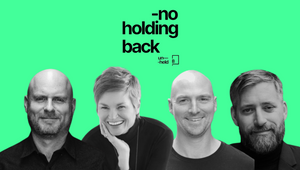
Kim Haxton on Managing Creatives

Kim Haxton is partner and creative director at Mythology, a New York-based creative agency, where she leads the advertising department.
Since joining in 2018, she has spearheaded major campaigns for established brands like Target, Coca-Cola, and Meta, while helping elevate emerging companies such as A24, Harry's, and JUST Egg. Kim's expertise spans brand creation, visual identity, and marketing strategy, demonstrated through successful launches of brands like Agua Magica and Staple Gin.
Prior to Mythology, Kim served as creative director at Wieden+Kennedy New York, building her reputation for distinctive consumer brand work. Her recent promotion to partner at Mythology recognises her six-year contribution to the agency's creative excellence and team culture.
Under her leadership, Mythology continues to innovate across luxury, retail, entertainment, and technology sectors, focusing on multidisciplinary approaches that define cultural moments.
LBB> What was your first experience of leadership?
Kim> I was the oldest child, so my first experience was telling my siblings what to do. It involved a lot of bribing, which was of course, very effective.
LBB> How did you figure out what kind of leader you wanted to be – or what kind of leader you didn’t want to be?
Kim> I’m still figuring it out. I read a lot. I seek advice from peers that I admire. I listen to podcasts. And while I have consistent practices and experience that have worked for me thus far, I try to continue to really listen to those around me and maintain a mindset that is always open to change if and when necessary.
LBB> What experience or moment gave you your biggest lesson in leadership?
Kim> Motherhood. There is no better training for any job than that. You become very good at learning on the job and decision-making in the moment. It is a constant exercise in problem-solving, patience, time management, psychology, and managing opinionated humans, haha.
And you want and need your children to thrive. You have to continually remind yourself that your goal is not to make more like you. Your goal is to guide them to be themselves. And that is a really important skill when managing creatives.
LBB> Did you know you always wanted to take on a leadership role? If so how did you work towards it and if not, when did you start realising that you had it in you?
Kim> No, in fact, I preferred to freelance and work for myself for a good part of my career.
I’m fairly introverted naturally, and my background is in graphic design and art direction, which requires a lot of introspection and independence. I’ve always found it interesting that in this business the path of growth for creative people is through management – something I think a lot of us are uncomfortable with.
But the part of the job I like most – making things – requires many, many people and if I really wanted to continue making things at the level I desired, that I was proud of, I’d have to get comfortable leading people.
LBB> When it comes to 'leadership' as a skill, how much do you think is a natural part of personality, how much can be taught and learned?
Kim> I believe that if you are curious, industrious, and open-minded, you can learn quite a bit.
LBB> What are the aspects of leadership that you find most personally challenging? And how do you work through them?
Kim> I want people to like me. Haha. And I’ve learned that in leadership, that has to be a by-product of the way you lead, not a goal from the outset.
I also think it’s important to be aware of my weaknesses but without the negative self-judgement that often comes with that awareness. Being able to take blame, admit mistakes and accept failure without the detrimental self-loathing that can often come with that is challenging.
But I’ve found that taking things less seriously and having a sense of humour and perspective is the antidote for me.
LBB> Have you ever felt like you've failed whilst in charge? How did you address the issue and what did you learn from it?
Kim> I fail every day! Because leadership is decisions, and when you’re making that many decisions daily, there is no perfect track record. When it happens, I try to accept responsibility, mentally note how I could react differently next time, and move on.
LBB> In terms of leadership and openness, what’s your approach there? Do you think it’s important to be as transparent as possible in the service of being authentic? Or is there a value in being careful and considered?
Kim> I’m not sure those things are either / or.
In managing creatives, it’s important to be transparent in what I expect, what the challenges of a situation are, etc., but not overwhelm anyone with the issues that might block them from doing their job. It is extremely important for creatives to feel safe; mutual vulnerability is usually a way toward that.
But that is different than weighing people down with your own baggage and challenges.
LBB> As you developed your leadership skills did you have a mentor, if so who were/are they and what have you learned? And on the flip side, do you mentor any aspiring leaders and how do you approach that relationship?
Kim> I’ve worked for and with so many talented people: Neal Arthur, Susan Hoffman, David Lubars, Mike Byrne, and Anthony Sperduti (currently). I don’t know if I would consider any of them mentors in the traditional sense, but I have certainly stolen so many good qualities from all of them!
I remember Susan telling me once that I was too responsible. She was right, and that was actually a really helpful unlock for me, because as a creative, it frees you up to know that someone else’s job is to worry about that.
It feels a bit presumptuous in the day-to-day of it all to assume my role as a mentor, but I see enormous individual growth on our team, and I’d be proud if someday any of it is attributed to me.
LBB> In continually changing market circumstances, how do you cope with the responsibility of leading a team through difficult waters?
Kim> What’s become obvious in the last few years is that we can not predict anything except change.
So, I focus instead on what is controllable, which is our reaction to that change. And that is where past experience, compassion, and a sense of humour and humility come in.
LBB> As a leader, what are some of the ways in which you’ve prioritised diversity and inclusion within your workforce?
Kim> Our currency is our ability to have the most compelling take on something. And this simply cannot be done with a homogenous group of people. So the most important thing we can do is hire people who differ from ourselves and each other in as many ways as possible.
LBB> How important is your company culture to the success of your business? And how have you managed to keep it alive with increases in remote and hybrid working patterns?
Kim> I think it’s important to look up from your desk and like the people that are sitting around you. But that does not come from outings or happy hours or rigid in-office policies. We put a lot of effort into hiring people we ultimately want to sit next to, and in my experience, the rest happens organically.
LBB> What are the most useful resources you’ve found to help you along your leadership journey?
Kim> Time alone. A long walk to nowhere is probably one of the more helpful tools I have.















